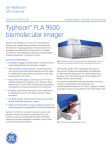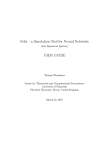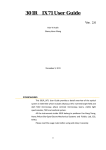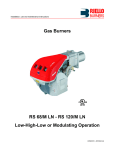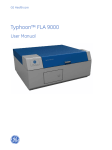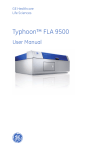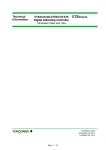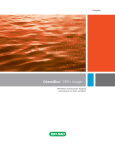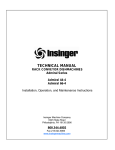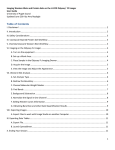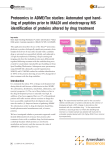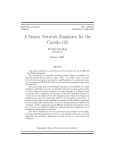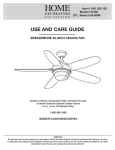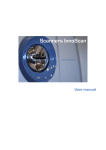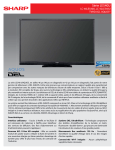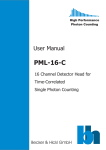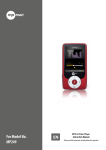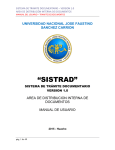Download Typhoon™ FLA 9000 biomolecular imager
Transcript
GE Healthcare Data file 28-9610-72 AB Imaging systems, software, and accessories Typhoon™ FLA 9000 biomolecular imager Typhoon FLA 9000 (Fig 1) is a versatile laser scanner for biomolecular imaging applications including sensitive and quantitative measurements of radioisotopic labels by storage phosphor, chemifluorescent Western blots, and multiplex fluorescence as well as digitization of colorimetric stains (e.g., Coomassie™ Blue and silver-stained gels). The system supports both 2-D Difference Gel Electrophoresis (DIGE) and Amersham™ ECL™ Plex™ Western blotting systems. Typhoon FLA 9000 delivers: • Versatility: image radioisotope-, multifluorescent-, chemifluorescent-, and colorimetric-labeled samples • High resolution and quantitation: a pixel resolution of up to 10 µm and a linear signal response over five orders of magnitude provides precise quantitation in gels, blots, tissue sections, and arrays • High sample throughput: A scanning area of 40 × 46 cm enables simultaneous imaging of up to 20 gels or blots, measuring 10 × 8 cm in size. This facilitates comparisons among blots, and reduces workload and waiting time. Fig 1. Typhoon FLA 9000 is a high performance biomolecular imager for sensitive and quantitative measurements. Typhoon FLA 9000 is a variable mode laser scanner with modular access to the optical components and excitation sources (Fig 2), providing both versatile and flexible imaging for precise quantitation of proteins, nucleic acids, and other biomolecules. The system provides several imaging modes such as fluorescence, filmless autoradiography, and digitization of colorimetrically stained gels (e.g., Coomassie Blue and silver stain). Chemiluminescence imaging is possible but for detection of low abundance proteins by chemiluminescence, the ImageQuant™ imager series is recommended. • Flexibility: optimized performance for new applications by adapting the system with stages, detectors, filters, and lasers • 2-D DIGE imaging: simultaneously image two 2-D DIGE gels for differential expression studies • Visible and infrared fluorescence imaging: optional near infrared excitation for imaging IRDye™ and other infrared dyes Fig 2. Filters are easily exchanged by the user. The system is optimized for: 2-D DIGE imaging for differential protein expression studies, Amersham ECL Plus chemifluorescent imaging for quantitative protein detection by Western blotting, and multifluorescent Amersham ECL Plex imaging for precise quantitation of two or more proteins in the same blot (Fig 3). CHO cell lysate 5000 2500 1250 630 310 160 78 (ng total protein) Sample: CHO cell lysate Membrane: Hybond™ LFP Target protein: β-tubulin (Cy™5, red) ERK 1/2 (Cy3, green) Detection: Primary antibodies: Mouse anti-tubulin and rabbit anti-MAP kinase ERK1/2 Secondary antibodies: ECL Plex goat anti-rabbit IgG-Cy3 ECL Plex goat anti-mouse IgG-Cy5 Imaging: Excitation Emission filter Cy3: 532 nm BPG1 (570DF20) Cy5: 635 nm LPR (665LP) LOD: β-tubulin in 160 ng CHO cell lysate (Cy5) ERK 1/2 in 78 ng CHO cell lysate (Cy3) Fig 3. Multiplex detection of endogenous proteins by Amersham ECL Plex Western blotting. Tubulin and ERK1/2 were targeted in a dilution series of CHO cell lysate by using mouse anti-tubulin and rabbit anti-MAP kinase ERK 1/2 primary antibodies. Secondary antibodies were ECL Plex anti-mouse Cy5 (red) and anti-rabbit Cy3 (green). Imaging was performed with Typhoon FLA 9000 using separate detection channels. Arrows indicate the limits of detection (LOD) in each detection channel. The minimal crosstalk and low background mean that it is possible to reliably quantitate specific signals relative to a housekeeping protein. A B C D Fig 4. (A) The Phosphor Stage, (B) Multi Stage, (C) Low Fluorescent Glass Plate Stage, and (D) Fluor Stage are designed to accommodate a variety of sample formats and imaging modes. 2 03/2010 28-9610-72 AB Table 1. Typhoon FLA 9000 specifications Detection modes: Fluorescence, phosphorimaging, digitization, and chemiluminescence Excitation wavelengths: 473 nm (blue LD laser), 532 nm (green SHG laser), 635 nm (red LD laser), 685 nm (optional near IR LD laser), and 785 nm (optional near IR LD laser) Radioisotopes: 3 H, 11C, 14C, 125I, 18F, 32P, 33P, 35S, 99mTc, and other sources of ionizing radiation Dynamic range: 5 orders of magnitude Bit depth: 16-bit Scanning area: 40 × 46 cm Pixel sizes: 10, 25, 50, 100, 200 µm, and prescan 1000 µm Standard filters: IP (Phosphorimaging), LPB (510LP), LPG (575LP), LPR (665LP), BPB1 (530DF20), and BPG1 (570DF20) Optional filters: BPFR700 (R715), BPFR800 (R810), DBR1 (530DF20/665LP), and DGR1 (570DF20/665LP) Dimensions (W × H × D): 900 × 400 × 800 mm Weight: 97 kg Line frequency: 50/60 Hz Temperature: 15°C to 30°C Humidity: 20% to 70% (no condensation) Supply voltage: 100 - 240 VAC ± 10% Power consumption: Approx. 0.3 kVA Technical features Optimal choice of filter, stage, laser and PMT Filters are easily accessed and exchanged without tools to attain optimal imaging conditions. The system accommodates up to four computer-controlled filter positions at any time. Custom filters can be easily installed by the user. Stages (Fig 4) give the correct positioning and stability for optimal imaging of a range of sample types. Samples that can be scanned include agarose and polyacrylamide gels, membranes, DIGE gels, radioisotope-labeled samples using a phosphorimaging plate, as well as microplates and glass slides with the titer plate (TP) plug‑in. The system can simultaneously scan two DIGE gels, each measuring up to 21.5 × 27.5 cm with the Low Fluorescent Glass Plate stage. The stages are easily removed from the system for cleaning. The system can be equipped for dual simultaneous fluorescence detection by the addition of a second photomultiplier tube (PMT). Each PMT is selected for optimal response to the detected emission wavelength. The standard bialkali PMT 1 is suitable for phosphorimaging and dyes Transferrin 5000 2500 1250 630 310 160 78 39 19.5 (pg) Typhoon FLA 9000 2500 1250 Transferrin 630 310 Sample: Transferrin Membrane: Hybond LFP Detection: Primary antibody: Rabbit anti-human transferrin Secondary antibody: Anti-rabbit IRDye 680 Imaging: Excitation Emission filter Typhoon: 685 nm BPFR700 (R715) LOD: 19.5 pg transferrin L: R2=0.990 DR: 2.1 orders of magnitude 160 78 35000 30000 25000 20000 15000 10000 5000 0 2500 1 2 Amount of transferrin (ng) 3 Transferrin 1250 630 310 160 78 39 19.5 (pg) 40000 30000 20000 10000 0 0 1 2 3 4 5 Amount of transferrin (ng) 6 Fig 5. A two-fold dilution series of transferrin starting at 5 ng was subjected to Western blotting and detected with a rabbit anti-transferrin primary antibody and anti-rabbit Alexa Fluor 633 secondary antibody. Results demonstrate detection in the red wavelength region with a linear signal response. Arrow indicates the limit of detection (LOD). The linear dynamic range (DR) was 2.1 orders of magnitude, and the linearity of the response (L) was R2=0.995. Sample: Transferrin Membrane: Hybond LFP Detection: Primary antibody: Rabbit anti-human transferrin Secondary antibody: Anti-rabbit IRDye 680 Imaging: Excitation Emission filter Odyssey: 685 nm 700 LOD: 19.5 pg transferrin 2 L: R =0.980 DR: 2.1 orders of magnitude 45000 Integrated Intensity (× 10-3) Integrated Intensity (× 10-3) Odyssey 50000 19.5 (pg) 40000 0 Sample: Transferrin Membrane: Hybond LFP Detection: Primary antibody: Rabbit anti-human transferrin Secondary antibody: Anti-rabbit Alexa Fluor 633 Imaging: Excitation Emission filter Alexa 633: 635 nm LPR (665LP) LOD: 39 pg transferrin 2 L: R =0.995 DR: 2.1 orders of magnitude 39 45000 Integrated Intensity (× 10-3) excited by blue (e.g., Cy2), green (e.g., Cy3), and red (e.g., Cy5 or Alexa Fluor™ 633) light (Fig 5) whereas the optional multialkali PMT 2 is optimal for dyes excited by far red and infrared light such as IRDye680 or IRDye800. In experiments using a secondary antibody labeled with IRDye 680, the performance of Typhoon FLA 9000, in terms of sensitivity, dynamic range and linearity of response was shown to be similar to that of the Odyssey™ Infrared Imaging System from LI-COR™ (Fig 6). 40000 35000 30000 25000 20000 15000 10000 5000 0 0 Scanning is rapid and detection is sensitive for laser-induced fluorescence, radioisotopic imaging by storage phosphor, and digitization. A fast 1000 µm prescan function gives a rapid overview of the sample for selecting the correct settings. At a pixel size of 200 µm, a 10 × 15 cm sample is scanned in two minutes. The system provides a linear signal response over five orders of magnitude. This, together with digitization of the image with up to 16-bit resolution, provides a suitable basis for the precise quantitation of proteins, DNA and other labeled molecules. Lasers can be exchanged in the field to accommodate new applications and fluorophores. The system can house up to four lasers simultaneously, from a choice of five laser excitation wavelengths (473, 532, 635, 685, and 785 nm). 1 2 Amount of transferrin (ng) 3 Fig 6. A two-fold dilution series of transferrin starting at 2.5 ng was subjected to Western blotting and detected with a rabbit anti-transferrin primary antibody and anti-rabbit IRDye 680 secondary antibody. Imaging by Typhoon FLA 9000 showed similar performance for detection in the near infrared wavelength region compared to the Odyssey Infrared Imaging System from LI-COR. Arrows indicate the LOD. The experiments were performed at GE Healthcare laboratories according to the manufacturers’ instructions. Optimal detection of chemifluorescent Western blots Laser scanning systems are not optimal for imaging chemiluminescence. Typhoon FLA 9000 does, however, perform well with Amersham ECL Plus by imaging its stable chemifluorescent signal, which is emitted upon excitation by the 473 nm laser. This provides a means to obtain optimal imaging performance from a chemifluorescent reagent. 03/2010 28-9610-72 AB 3 Ettan™ DIGE system Ettan DIGE system is an integrated solution for accurate quantitation of changes in protein expression. Typhoon FLA 9000 is a fully optimized part of Ettan DIGE system with DeCyder™ 2D Differential Analysis Software (Fig 7). The strengths of Typhoon FLA 9000—high sensitivity and broad dynamic range for measuring low and high abundant proteins in one scan (Fig 8)—make it highly suited for 2-D DIGE applications, enabling the user to detect and accurately quantitate subtle changes in protein expression. By generating overlaid, multichannel images for each gel with minimal crosstalk, Typhoon FLA 9000 exploits the multiplexing potential of CyDye™ DIGE fluors to remove experimental variation between gels. Images are analyzed using DeCyder 2D to accurately and confidently measure very small differences in protein abundance. Imaging For the detection of radioactivity, fluorescence and chemifluorescence, emitted light is collected and transformed to an electrical signal by a photomultiplier tube (PMT). The electrical signal is then converted into digital information by A/D conversion for image display and analysis. Detection of radioactivity Samples containing radioactive probes are exposed to a storage phosphor screen. Light is emitted from the screen in proportion to the amount of radioactivity in the sample upon laser-induced stimulation. Sample: CHO cell lysate, expressing monoclonal antibody (MAb) grown under various culture conditions Gel: Large precast DIGE Gel (within glass cassette) Imaging: Excitation Emission filter Cy2: 473 nm BPB1 (530DF30) Cy3: 532 nm BPG1 (570DF20) Cy5: 635 nm LPR (665LP) Fig 7. CHO cells expressing MAb were grown in different culture media. 2-D DIGE was used to analyze the expression of host cell proteins as part of efforts to improve MAb process understanding. Image analysis was performed using DeCyder 2D software. Fluorescence Upon excitation, light is emitted from a fluorescently labeled sample in proportion to the amount of labeled compound in the sample. Multiple fluorescent wavelengths can be detected with minimal crosstalk for comparative expression experiments. See Table 3 for emission filters. Carbonic anhydrase 409.6 204.8 102.4 51.2 25.6 12.8 6.4 3.2 1.6 0.8 0.4 0.2 (ng) Upon excitation, light is emitted from a fluorescent product generated in an enzyme-catalyzed reaction, in proportion to the amount of labeled compound in the sample. Digitization Excitation light passes through the sample and excites a fluorescent plate. The emitted light from the plate passes through the sample again and is collected and converted to an electrical signal. The method is suitable for documentation of colorometrically stained gels. Sample: Label: Carbonic anhydrase CyDye DIGE fluor, Cy3 minimal dye Gel: 12% acrylamide Tris-glycine Imaging: Excitation Emission filter Cy3: 532 nm BPG1 (570DF20) LOD: 0.2 ng carbonic anhydrase 2 L: R =0.998 DR: 3.3 orders of magnitude Integrated Intensity (× 10-3) Chemifluorescence 70000 60000 50000 40000 30000 20000 10000 0 0 100 200 300 400 500 Amount of carbonic anhydrase (ng) Fig 8. Different concentrations of carbonic anhydrase were labeled with CyDye DIGE fluor, Cy3 minimal dye and subjected to 1-D electrophoresis. The gel was imaged with Typhoon FLA 9000. The detection limit (LOD) was 0.2 ng carbonic anhydrase and the linear DR was 3.3 orders of magnitude. Arrow indicates the LOD. 4 03/2010 28-9610-72 AB Chemiluminescence The light detection path is scanned across the sample without illumination. The emitted chemiluminescence from each scanned point is collected and transformed to an electrical signal by a PMT. The electrical signal is then converted into digital information by A/D conversion for image display and analysis. Data storage Data are stored either in linear 16-bit grayscale TIFF (.TIF file format) or in square root encoded 16-bit TIFF (.GEL file format). The .GEL format encoding provides higher dynamic resolution than .TIF at lower signal levels to exploit the low signal detection capability of the phosphorimaging technology. Image analysis Designed for seamless data transfer and quantitative gel and blot analysis, we provide image analysis software for use with Typhoon FLA 9000 (Table 2). Table 2. Image analysis software Software Analysis ImageQuant TL 1-D gel electrophoresis, dot blots, arrays, colony counting, and user-defined gel analysis DeCyder 2D Differential high-resolution 2-D DIGE analysis including Extended Data Analysis ImageMaster 2D Platinum 2-D gels, including single stain and 2-D DIGE Table 3. Emission filters Filter type Wavelength range (nm) IP BP390 Detection examples Phosphorimaging LPB (510LP) ≥ 510 Cy2, ECL Plus, SYBR™ Green, FAM™, FITC, Alexa Fluor 488, SYPRO™ Ruby, SYPRO Orange, GFP BPB1 (530DF30) 515 to 545 Cy2 DIGE Fluor, ECL Plex Cy2 LPG (575LP) ≥ 575 Cy3, Deep Purple™, HEX, Alexa Fluor 532 and 555, SYPRO Red BPG1 (570DF20) 560 to 580 Cy3 DIGE Fluor, ECL Plex Cy3 LPR (665 LP) ≥ 665 Cy5, Alexa Fluor 633, TOTO™ 3, DiD, Cy5 DIGE Fluor, ECL Plex Cy5 BPFR700 (R715) 713 to 726 Alexa Fluor 700, IRDye680, IRDye700 BPFR800 (R810) 814 to 826 Alexa Fluor 790, IRDye800 03/2010 28-9610-72 AB 5 Imager performance Typhoon 9400/9410 Typhoon FLA 9000 Typhoon Trio/Trio+ Typhoon FLA 7000 Storage Phosphor 3 H, 11C, 14C, 125I, 18F, 32P, 33P, 35S, 99mTc, and other sources of ionizing radiation ++++ ++++ ++++ ++++ Macroarray (radiolabeled) ++++ ++++ ++++ — Fluorescence—Proteins CyDye DIGE Fluors Cy2 Cy3 Cy5 ++++ ++++ ++++ +++ ++++ ++++ ++++ ++++ ++++ —* —* —* ECL Plex Fluors Cy2 Cy3 Cy5 ++++ ++++ ++++ +++ ++++ ++++ ++++ ++++ ++++ —* —* —* Protein Stains Deep Purple Total Protein Stain SYPRO Ruby NanoOrange™ (solutions) Pro-Q Diamond (phosphorylated proteins) Pro-Q Sapphire 532 (Histidine-tagged proteins) ++++ ++++ ++++ ++++ +++ ++++ ++++ ++++ +++ +++ ++++ +++ ++++ ++ ++++ +++ ++++ ++ ELISA AttoPhos Fluorescence—Nucleic acids Cy3 and Cy5 Alexa Fluor 532 and Alexa Fluor 633 Nucleic acid stains Ethidium Bromide (post stain) Vistra Green, SYBR Gold, SYBR Green I and II PicoGreen, RiboGreen ++++ +++ ++++ ++++ ++++ +++ ++++ ++++ ++++ +++ ++++ +++ ++++ +++ ++++ ++++ +++ +++ +++ +++ +++ ++++ +++ ++++ ++++ ++ ++ +++ +++ Chemifluoresence (enzyme-catalyzed) Amersham ECL Plus Western blotting ++++ ECF, AlkPhos direct ECF ++++ DDAO Phosphate ++++ Other applications Cy2 Cy3 Cy5 Fluorescein, FAM, FITC, Alexa Fluor 488 TET, HEX, ROX, TAMRA Green fluoresecent protein ++++ ++++ ++++ +++ ++++ ++++ ++++ ++++ ++++ ++ +++ +++ ++++ ++++ +++ ++++ +++ +++ ++++ ++++ +++ +++ ++ ++ Chemiluminescence + + + — Amersham ECL Amersham ECL Plus Amersham ECL Advance™ ++++ Superior performance +++ High performance ++ Good performance + Acceptable performance — Not compatible Ratings are based on overall system performance including model-specific features, versatility, and sensitivity (limit of detection). Blank fields indicate that data are not available. * Multiplex experiments (e.g., 2-D DIGE and Amersham ECL Plex) cannot be performed on Typhoon FLA 7000. CyDye DIGE Fluors and Amersham ECL Plex conjugates can be imaged in single probe experiments on Typhoon FLA 7000 (i.e., experiments where there is only one dye or conjugate on the gel or membrane). 6 03/2010 28-9610-72 AB Ordering information System Typhoon FLA 9000 * Quantity Code no. 1 28-9558-08 *Includes 473 nm, 532 nm, and 635 nm lasers, filter tray, IP filter, LPB filter, LPG filter, LPR filter, BPB1 filter, BPG1 filter, Fluor Stage, Membrane Weight, Phosphor Stage, Low Fluorescent Glass Plate Stage, Multi Stage, and TP plug-in. Fluorescent plate for digitization, capture software, USB cable, mains cables (EU and USA), User Manual and Getting Started Guide. Upgrades and accessories Quantity Code no. Fluor Stage Set 1 28-9589-04 1 28-9564-19 1 28-9564-74 1 28-9564-75 1 28-9564-76 1 28-9564-77 1 28-9564-78 1 28-9564-81 1 28-9564-82 Fluor Stage, Membrane Weight Multi Stage Set Multi Stage, TP plug-in BAS-IP MS 2040 E Phosphorimaging plate, 20 × 40 cm, multipurpose BAS-IP MS 2025 E Phosphorimaging plate, 20 × 25 cm, multipurpose BAS-IP MS 3543 E Phosphorimaging plate, 35 × 43 cm, multipurpose BAS-IP SR 2040 E Phosphorimaging plate, 20 × 40 cm, high resolution BAS-IP SR 2025 E Phosphorimaging plate, 20 × 25 cm, high resolution BAS-IP TR 2040 E Phosphorimaging plate, 20 × 40 cm, for Tritium detection BAS-IP TR 2025 E Phosphorimaging plate, 20 × 25 cm, for Tritium detection FLA Image Eraser 1 28-9564-73 685 nm laser upgrade 1 28-9610-22 1 28-9610-25 1 28-9610-32 685 nm laser, BPFR700 filter, PMT2, installation, and testing 785 nm laser upgrade 785 nm laser, BPFR800 filter, PMT2, installation, and testing 685 + 785 nm laser upgrade 685 nm and 785 nm lasers, BPFR700 filter, PMT2, BPFR800 filter, installation, and testing Related literature Typhoon FLA 7000 biomolecular imager, Data file Code no. 28-9610-73 Minimum computer requirement OS: Windows™ XP™ SP3 (32-bit) or Windows Vista™ Business SP1 (32-bit), RAM: more than 1 GB, Processor: Intel™ Core 2 Duo processors, Hard disk: more than 80 GB, USB Ports: USB 2.0, Optical drive: DVD-ROM or Super Multi Drive, Monitor: 1280 × 1024 pixel resolution or higher Please contact your local sales representative for the latest recommended computer configuration. 03/2010 28-9610-72 AB 7 For local office contact information, visit www.gelifesciences.com/contact www.gelifesciences.com/quantitative_imaging GE Healthcare Bio-Sciences AB Björkgatan 30 751 84 Uppsala GE, imagination at work, and GE monogram are trademarks of General Electric Company. Amersham, Cy, CyDye, DeCyder, Deep Purple, ECL, ECL Advance, ECL Plex, Ettan, Hybond, ImageQuant, and Typhoon are trademarks of GE Healthcare companies. 2-D DIGE: 2-D Fluorescence Difference Gel Electrophoresis (2-D DIGE) technology is covered by US patent numbers 6,043,025, 6,127,134 and 6,426,190 and equivalent patents and patent applications in other countries and exclusively licensed from Carnegie Mellon University. DeCyder: This release of DeCyder version 2 (software) is provided by GE Healthcare to the customer under a non-exclusive license and is subject to terms and conditions set out in the 2-D Differential Gel Electrophoresis Technology Access Agreement. Customer has no rights to copy or duplicate or amend the Software without the prior written approval of GE Healthcare. Deep Purple Total Protein Stain: Deep Purple Total Protein Stain is exclusively licensed to GE Healthcare from Fluorotechnics Pty Ltd. Deep Purple Total Protein Stain may only be used for applications in life science research. Deep Purple is covered under a granted patent in New Zealand entitled “Fluorescent Compounds”, patent number 522291 and equivalent patents and patent applications in other countries. ECL Advance: ECL Advance contains Lumigen TMA-6 substrate and is sold under exclusive license from Lumigen Inc. ECL Plus contains Lumigen PS3 substrate and is sold under exclusive license from Lumigen Inc. CyDye: This product or portions thereof is manufactured under an exclusive license from Carnegie Mellon University under US patent number 5,268,486 and equivalent patents in the US and other countries. Cy3-UTP or Cy5-UTP, Cy3. 5-dCTP or Cy5.5-dCTP, Cy3-CTP or Cy5-CTP: These products are manufactured for GE Healthcare UK Limited by Perkin Elmer Life Sciences under US patent numbers 5047519 and 5151507. The cyanine dyes in the product are manufactured under an exclusive license from Carnegie Mellon University under US patent numbers 5,268,486 and equivalent patents in the US and other countries. The purchase of CyDye products includes a limited license to use the CyDye products for internal research and development but not for any commercial purposes. A license to use the CyDye products for commercial purposes is subject to a separate license agreement with GE Healthcare. Commercial use shall include: 1. Sale, lease, license or other transfer of the material or any material derived or produced from it. 2. Sale, lease, license or other grant of rights to use this material or any material derived or produced from it. 3. Use of this material to perform services for a fee for third parties, including contract research and drug screening. If you require a commercial license to use this material and do not have one, return this material unopened to GE Healthcare Bio-Sciences AB, Bjorkgatan 30, SE-751 84 Uppsala, Sweden and any money paid for the material will be refunded. All third party trademarks are the property of their respective owners. Odyssey is a trademark of LI-COR Biosciences. ©2009–2010 General Electric Company—All rights reserved. First published Oct. 2009. All goods and services are sold subject to the terms and conditions of sale of the company within GE Healthcare which supplies them. A copy of these terms and conditions is available on request. Contact your local GE Healthcare representative for the most current information. GE Healthcare UK Limited Amersham Place Little Chalfont Buckinghamshire, HP7 9NA UK GE Healthcare Europe, GmbH Munzinger Strasse 5 D-79111 Freiburg Germany GE Healthcare Bio-Sciences Corp. 800 Centennial Avenue, P.O. Box 1327 Piscataway, NJ 08855-1327 USA GE Healthcare Japan Corporation Sanken Building 3-25-1 Hyakunincho, Shinjuku-ku, Tokyo 169-0073 Japan 28-9610-72 AB 03/2010








